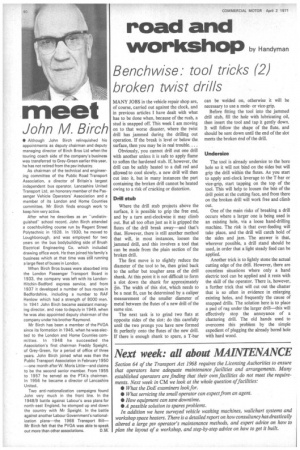road and
Page 42

If you've noticed an error in this article please click here to report it so we can fix it.
workshop by Handyman
Bench wise; tool tricks (2) broken twist drills
MANY JOBS in the vehicle repair shop are, of course, carried out against the clock, and in previous articles I have dealt with what has to be done when, because of the rush, a stud is snapped off. This week I am moving on to that worse disaster, where the twist drill has jammed during the drilling out operation. If the break is level or below the surface, then you may be in real trouble....
Obviously, you cannot drill out one drill with another unless it is safe to apply flame to soften the hardened stub. If, however, the drill can be safely heated to a dull red and allowed to cool slowly, a new drill will then cut into it, but in many instances the part containing the broken drill cannot be heated owing to a risk of cracking or distortion.
Drill stub Where the drill stub projects above the surface, it is possible to grip the free end, and by a turn anti-clockwise it may climb out. But all too often just as it is gripped the flutes of the drill break away—and that's that. However, there is still another method that will, in most instances, loosen the jammed drill, and this involves a tool that can be made from the plain section of the broken drill.
The first move is to slightly reduce the diameter of the tool to be, then grind back to the softer but tougher area of the drill shank. At this point it is not difficult to form a slot down the shank for approximately +in. The width of this slot, which needs to be a neat fit, can be determined by a caliper measurement of the smaller diameter of metal between the flutes of a new drill of the same size.
The next task is to grind two flats at opposite sides of the slot: do this carefully until the two prongs you have now formed fit perfectly onto the flutes of the new drill. If there is enough shank to spare, a T-bar can be welded on, otherwise it will be necessary to use a moleor vice-grip.
Before fitting the tool into the jammed drill stub, fill the hole with lubricating oil, then insert the tool and tap it gently down. It will follow the shape of the flute, and should be sent down until the end of the slot meets the broken end of the drill.
Undersize The tool is already undersize to the bore hole so it will not bind on the sides but will grip the drill within the flutes. As you start to apply anti-clock leverage to the T-bar or vice-grip, start tapping on the top of the tool. This will help to loosen the bite of the drill point at the cutting face, and from there on the broken drill will work free and climb out.
One of the main risks of breaking a drill occurs where a larger one is being used in an existing hole, via a loose hand-drilling machine. The risk is that over-feeding will take place, and the drill will catch hold of the sides and jam. The answer is that, wherever possible, a drill stand should be used, in order that a tight steady feed can be applied.
Another trick is to lightly stone the actual cutting edge of the drill. However, there are countless situations where only a hand electric tool can be applied and it rests with the skill of the operator. There is, however, a further trick that will cut out the chatter that is so often in evidence in enlarging existing holes, and frequently the cause of snapped drills. The solution here is to place a pad of rag under the larger drill—this will effectively stop the annoyance of a chattering drill. The old hands used to overcome this problem by the simple expedient of plugging the already bored hole with hard wood.




























































































